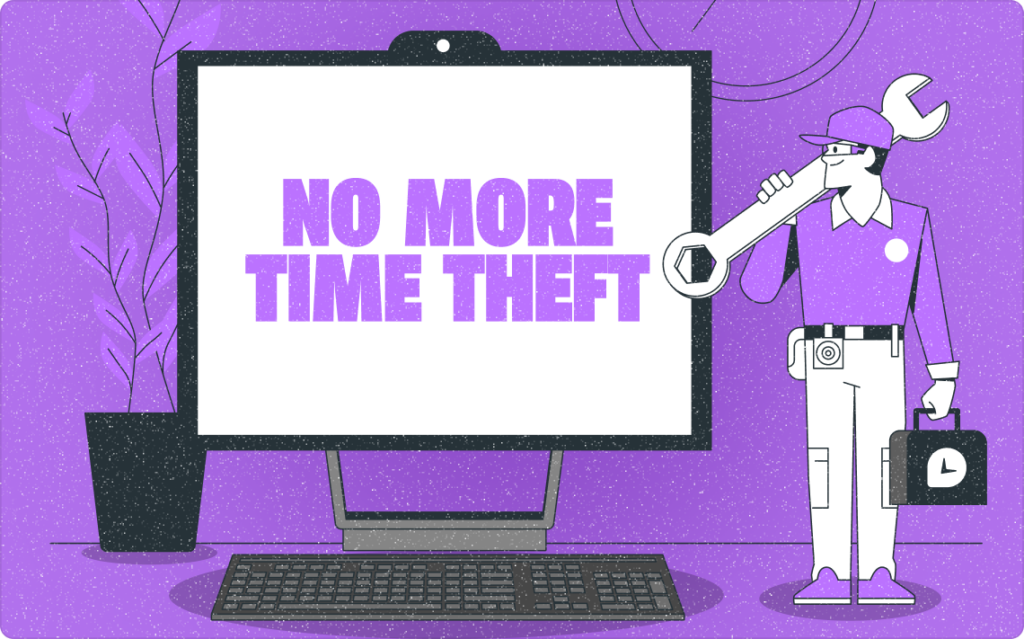The Hidden Cost of Doing Nothing: Addressing Time Theft in the Workplace

Understanding Time Theft
Defining Time Theft in the Modern Workplace
Time theft may not leave a physical trace, but its impact on an organization can be just as detrimental as tangible forms of theft. Time theft occurs when employees are on the clock but not actively engaged in work-related activities. This can manifest in various behaviors that detract from their productivity and, by extension, the company’s performance.
- Personal Tasks: Using work time for personal activities like online shopping or managing personal finances.
- Excessive Breaks: Taking longer or more frequent breaks than permitted.
- Buddy Punching: Clocking in or out for a colleague.
- Socializing: Spending an inordinate amount of time on non-work-related conversations.
The modern workplace, with its blend of in-office and remote work environments, has made it more challenging to monitor and define time theft. The digital age has introduced new avenues for time-wasting activities that are often harder to detect than traditional forms. As such, understanding the nuances of time theft in today’s work culture is the first step towards addressing it.
The Various Forms of Time Theft
Time theft can manifest in numerous ways, often going unnoticed until it accumulates into significant losses. At its core, it involves employees receiving pay for time not actually spent on work-related tasks. Here are some common examples:
- Buddy Punching: This occurs when a coworker clocks in or out for another employee who is not present.
- Extended Breaks: Taking longer than allotted for lunch or other scheduled breaks.
- Personal Business: Using work time to handle personal matters, such as online shopping or attending to personal emails.
- Socializing: Excessive chatting or socializing with coworkers during work hours.
- Internet Misuse: Spending work hours on non-work-related internet activities, such as social media or entertainment websites.
Each form of time theft may seem minor in isolation, but when combined, they can lead to a substantial drain on a company’s resources. It’s not just about the direct loss of productive hours; it’s also about the harder-to-measure costs, such as the impact on team dynamics and overall workplace morale.
Assessing the Impact on Productivity and Morale
The repercussions of time theft extend beyond mere financial losses; they strike at the very heart of workplace productivity and employee morale. When employees engage in time theft, the immediate effect is a reduction in the amount of work being completed. This not only slows down project timelines but can also lead to missed deadlines and a backlog of tasks.
Moreover, time theft can create an environment of mistrust and inequality. Employees who are diligent and manage their time effectively may feel demoralized when they perceive others as not contributing equally. This can lead to:
- A decrease in overall team cohesion.
- Resentment among staff members who adhere to their schedules.
- A potential increase in turnover rates as employees seek workplaces with fairer work practices.
Ultimately, the impact on morale can be just as costly as the direct financial implications. A demotivated workforce is less likely to be innovative or go the extra mile, which can stifle a company’s growth and competitive edge. Addressing time theft is not just about recovering lost hours; it’s about nurturing a productive, engaged, and equitable workplace.
Get more out of your business
Get the best employee engagement content every week via mailing list

The Root Causes of Time Theft
Workplace Culture and Employee Engagement
The ethos of a workplace significantly influences employee behavior, including their engagement with time theft. A positive culture that fosters mutual respect, recognition, and a sense of belonging can motivate employees to be more productive and honest with their time. Conversely, a toxic environment may lead to disengagement and a higher propensity for time theft.
- Mutual Respect: When employees feel respected, they are more likely to respect company time.
- Recognition: Regular acknowledgment of employees’ hard work can discourage time theft as they feel valued.
- Sense of Belonging: Cultivating a strong team spirit reduces the likelihood of time theft as employees take pride in their contributions.
To address time theft, organizations must first assess and, if necessary, overhaul their workplace culture. Engaging employees through regular feedback, transparent communication, and opportunities for professional growth can create an environment where time theft is less likely to occur. This engagement not only deters time theft but also contributes to overall job satisfaction and employee retention.
Inadequate Supervision and Lack of Accountability
In many organizations, time theft can often be traced back to a lack of proper supervision and accountability. Without clear expectations and consistent oversight, employees may feel less compelled to manage their time effectively, leading to increased instances of time theft.
- Lack of Direct Oversight: When supervisors are not regularly monitoring or engaging with their teams, it can create an environment where time theft goes unnoticed and unaddressed.
- Unclear Policies: Without well-defined policies regarding time management, employees may not understand the boundaries of acceptable behavior.
- Inadequate Consequences: A lack of consequences for time theft can send the message that this behavior is tolerated, further exacerbating the problem.
To combat these issues, organizations must establish robust supervision practices and hold individuals accountable for their time. This involves setting clear policies, providing regular feedback, and enforcing consequences for time theft. By doing so, companies can create a more disciplined and productive work environment.
Technological Distractions and Personal Mismanagement
In today’s digital age, the workplace is rife with technological distractions that can lead to time theft. Employees may find themselves losing significant portions of their workday to non-work-related internet browsing, social media, and personal email. Smartphones, with their constant notifications and easy access to apps and games, only exacerbate the issue.
Personal mismanagement of time also plays a crucial role. Without proper time management skills, employees can easily misallocate their hours, focusing on low-priority tasks while urgent responsibilities fall by the wayside. This mismanagement can stem from a lack of clear goals, poor planning, or simply the human tendency to procrastinate.
To address these challenges, companies can consider the following steps:
- Establish clear policies regarding personal device usage during work hours.
- Provide training on time management techniques and tools.
- Encourage regular breaks to reduce the temptation of digital distractions.
- Utilize software that helps monitor and manage employee productivity.
By tackling technological distractions and personal mismanagement head-on, businesses can reclaim lost time and enhance overall efficiency.

Measuring the Financial Implications
Quantifying the Cost of Lost Time
The financial toll of time theft on a business can be substantial, yet it often goes unnoticed due to its covert nature. To quantify this cost, companies must consider both direct and indirect losses. Direct costs are straightforward and include wages paid for time not actually worked. Indirect costs, however, can be more insidious and have a lasting impact on the organization.
- Direct Costs: These are the wages paid to employees for the time during which they were not productively engaged in work-related activities. Calculating this involves analyzing payroll data against actual work output.
- Indirect Costs: These encompass a range of factors including decreased productivity among other employees, potential overtime to compensate for lost work, and the erosion of customer satisfaction due to delayed services or reduced quality.
To accurately measure the financial implications, businesses must adopt a holistic approach, taking into account the various ways in which time theft can permeate and affect different areas of operations. This requires a combination of data analysis, employee feedback, and an understanding of the organization’s workflow and output.
The Ripple Effect on Business Operations
Time theft extends beyond the immediate loss of productivity. Its repercussions cascade through various aspects of business operations, often in subtle but significant ways. For instance, when employees engage in time theft, it can lead to:
- Inequitable Work Distribution: As some team members spend less time on actual work, their responsibilities may shift onto their more diligent colleagues, leading to an imbalance in workload and potential burnout.
- Delayed Project Timelines: Time not spent on tasks directly contributes to project delays, which can disrupt schedules, client relationships, and ultimately, the company’s reputation.
- Increased Operational Costs: Businesses may find themselves compensating for lost time by hiring additional staff or paying overtime, which inflates operational costs unnecessarily.
Moreover, the indirect effects of time theft can be just as damaging. A culture that tolerates time theft may experience a decline in overall employee morale, as it undermines the value of hard work and fairness. This can lead to a decrease in team cohesion and an increase in turnover rates, which further strains resources and hampers long-term growth. Addressing time theft is not just about recovering lost hours; it’s about preserving the integrity and efficiency of the entire operation.
Comparing Time Theft to Other Forms of Workplace Theft
Time theft may not leave a physical trace like stolen goods or embezzled funds, but its impact on a business can be just as significant. Unlike traditional forms of theft that are often one-time incidents, time theft can be a continuous drain on resources, often going unnoticed for extended periods.
When compared to other forms of workplace theft, time theft is unique in several ways:
- Prevalence: Time theft is more widespread and can involve a larger number of employees, whether intentional or not.
- Detection: It is typically harder to detect than physical theft due to its intangible nature.
- Cultural Impact: Time theft can subtly undermine workplace culture and morale, whereas direct theft creates immediate and clear violations of trust.
Addressing time theft requires a different approach than other thefts. It’s not just about tightening security or increasing surveillance; it’s about creating an environment where employees are motivated to contribute their time effectively. This involves understanding the nuances of human behavior and the workplace dynamics that can lead to time theft.

Strategies to Mitigate Time Theft
Implementing Effective Time Tracking Systems
The adoption of effective time tracking systems is a pivotal step in combating time theft. These systems not only provide a clear record of employees’ work hours but also help in identifying patterns of time misuse. When selecting a time tracking solution, it’s important to consider the following:
- Ease of use: The system should be user-friendly to encourage compliance and minimize resistance.
- Integration capabilities: It should seamlessly integrate with other business systems, such as payroll and project management tools.
- Real-time monitoring: To offer immediate insights and enable proactive management of potential issues.
Once a system is in place, it’s crucial to establish clear policies regarding its use. Employees should be informed about the reasons for monitoring, how the data will be used, and the consequences of time theft. This transparency fosters trust and discourages misuse. Additionally, regular audits of time tracking data can help ensure accuracy and fairness, and provide opportunities for process improvements.
Fostering a Culture of Responsibility and Transparency
Creating an environment where employees feel accountable for their time and actions is essential in mitigating time theft. This involves clear communication of expectations and the establishment of trust between management and staff. When employees understand the value of their contributions and see the direct impact of their work, they are more likely to take ownership of their responsibilities.
To foster such a culture, consider the following steps:
- Set Clear Expectations: Clearly define work hours, breaks, and acceptable use of company time. Ensure that these policies are well communicated and understood by all employees.
- Encourage Open Dialogue: Create channels for employees to discuss workload and time management challenges. This can help identify areas where support is needed and prevent potential time theft.
- Lead by Example: Management should model the behavior they expect from their employees. This includes adhering to the same time management policies they set for their teams.
- Recognize and Reward: Acknowledge employees who manage their time effectively and contribute positively to the company. This not only motivates individuals but also sets a benchmark for others.
By taking these steps, organizations can create a more responsible and transparent workplace, which can significantly reduce the occurrence of time theft.
Training and Awareness Programs
Training and awareness programs are essential in combating time theft by educating employees about its implications and the importance of time management. These programs should aim to clarify company policies and the consequences of time theft, while also providing strategies for efficient work habits.
Key components of these programs include:
- Understanding Time Theft: Employees need to recognize what constitutes time theft and why it’s detrimental to both the company and their own professional growth.
- Policy Education: Clear communication about workplace policies helps ensure that all employees are aware of the expectations and rules regarding time management.
- Skill Development: Offering workshops on time management and productivity can empower employees to use their time more effectively.
- Reporting Mechanisms: Educating staff on how to report observed time theft discreetly can help in early detection and prevention.
By fostering an environment where time is valued and good practices are rewarded, organizations can significantly reduce the occurrence of time theft. Regular refresher sessions can help maintain awareness and keep time theft at the forefront of workplace priorities.

Legal and Ethical Considerations
When addressing time theft, employers must carefully consider the legal implications of monitoring their employees. The laws governing workplace surveillance vary significantly by jurisdiction, and what is permissible in one country or state may be illegal in another. It is crucial for organizations to understand and comply with the relevant privacy laws and regulations to avoid legal repercussions.
Key legal considerations include:
- Consent: In many regions, employers are required to inform employees about monitoring practices and, in some cases, obtain their consent.
- Reasonableness: The extent of monitoring must be reasonable and often should be proportionate to the perceived problem of time theft.
- Data Protection: Employers must ensure that any data collected through monitoring is securely stored and used in accordance with data protection laws.
Employers should seek legal counsel to develop policies that are both effective in preventing time theft and compliant with the law. This not only protects the company from potential lawsuits but also maintains trust with employees, which is essential for a productive work environment.
Balancing Privacy Rights with Employer Interests
In the quest to mitigate time theft, employers must tread carefully to maintain a balance between monitoring employee activities and respecting their privacy rights. The introduction of surveillance measures, such as software tracking or video monitoring, can be perceived as intrusive and foster a climate of distrust if not handled correctly.
To strike the right balance, employers should consider the following steps:
- Clearly communicate the purpose and scope of monitoring to all employees, ensuring transparency about what is being tracked and why.
- Establish clear policies that define acceptable use of company time and resources, and the consequences of time theft.
- Seek consent where necessary, especially in jurisdictions with stringent privacy laws, to avoid legal repercussions.
- Limit monitoring to work-related activities and ensure that personal data is protected and handled in accordance with privacy regulations.
By taking these measures, employers can protect their interests without infringing on the rights and dignity of their employees. It is a delicate equilibrium that requires ongoing dialogue and a commitment to ethical practices.
Ethical Approaches to Discouraging Time Theft
When addressing time theft, it’s crucial to adopt strategies that are not only effective but also ethical. Employers must strike a balance between discouraging time theft and respecting the rights and dignity of their employees. Here are some ethical approaches to consider:
- Promote a Positive Work Environment: Encourage an atmosphere where employees feel valued and motivated. Recognition programs and opportunities for growth can lead to increased job satisfaction and reduced time theft.
- Clear Communication of Policies: Ensure that all employees are aware of what constitutes time theft and the consequences of such actions. Transparency in policy communication helps employees understand expectations and the importance of adhering to them.
- Provide Adequate Resources: Employees should have the necessary tools and support to perform their duties efficiently. This includes proper training, access to technology, and a conducive work environment.
- Encourage Open Dialogue: Create channels for employees to voice concerns and suggestions. An open-door policy can help identify issues that may contribute to time theft and allow for collaborative problem-solving.
- Fair and Consistent Enforcement: When policies are violated, it’s important to enforce them consistently and fairly. Arbitrary or discriminatory enforcement can erode trust and lead to further ethical issues.
By implementing these ethical approaches, employers can create a workplace that naturally discourages time theft while fostering a culture of trust and integrity.
Frequently Asked Questions
How does time theft affect productivity and morale?
Time theft can significantly reduce productivity as it leads to less actual work being done. It can also harm team morale, especially if some team members are consistently engaging in time theft while others are working diligently.
What are some root causes of time theft?
Common causes include a lack of engagement, poor workplace culture, inadequate supervision, lack of accountability, and personal mismanagement of time due to technological distractions.
Can time theft be measured financially?
Yes, businesses can quantify the cost of time theft by calculating the wages paid for unproductive hours. This can be compared to other forms of workplace theft to understand its financial impact.
What strategies can employers implement to mitigate time theft?
Employers can implement time tracking systems, foster a culture of responsibility and transparency, and provide training and awareness programs to mitigate time theft.
Are there legal and ethical considerations when monitoring employees for time theft?
Yes, employers must navigate the legal landscape regarding employee monitoring to ensure they do not infringe on privacy rights. Additionally, they should adopt ethical approaches when addressing time theft to maintain trust and respect with employees.


